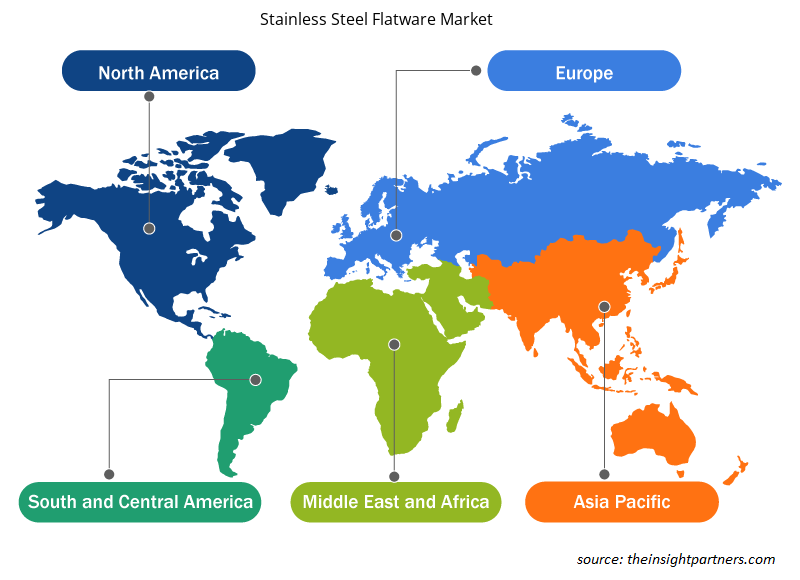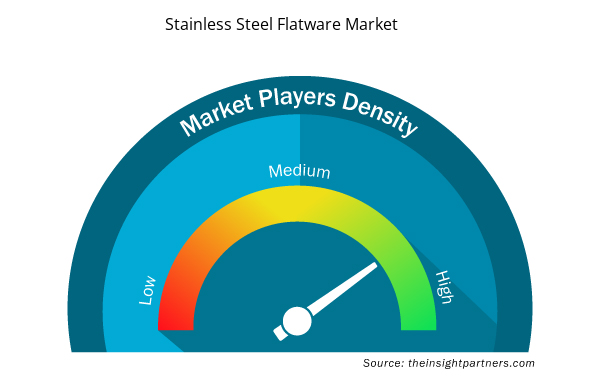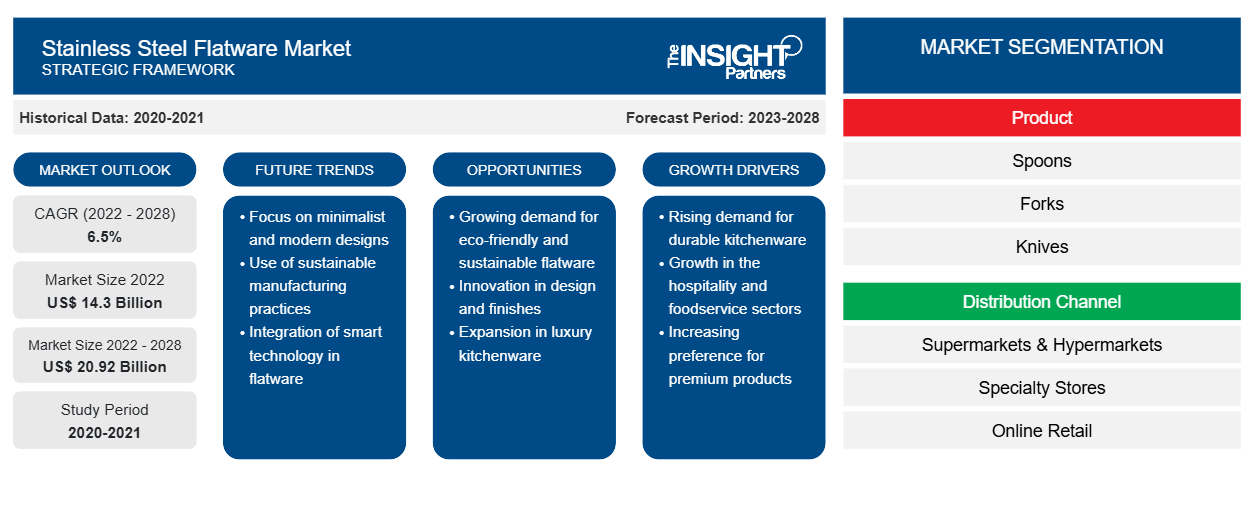Der Markt für Edelstahlbesteck wurde im Jahr 2022 auf 14.299,83 Millionen US-Dollar geschätzt und dürfte von 2022 bis 2028 mit einer durchschnittlichen jährlichen Wachstumsrate von 6,5 % wachsen.
Der globale Markt für Edelstahlbesteck wächst aufgrund der zunehmenden Sorge um die Gesundheit der Verbraucher und der gestiegenen Vorliebe für ästhetisches Besteck, das den Esstisch schmückt. Darüber hinaus legen zahlreiche Verbraucher Wert auf Erschwinglichkeit und Langlebigkeit der Produkte. Edelstahlbesteck hat aufgrund der Kosteneffizienz des Produkts an Beliebtheit gewonnen. Darüber hinaus gab es während der COVID-19-Pandemie aufgrund von Beschränkungen und der Schließung von Einzelhandelsgeschäften einen Anstieg des Kaufs von Edelstahlbesteck über Online-Vertriebsplattformen. Darüber hinaus kurbeln die zunehmende Verbreitung einzigartiger Küchen und die Verwendung von Spezialbesteck in Verbindung mit dem Einfluss westlicher Kochstile das Marktwachstum an.
Der Markt für Edelstahlbesteck wird durch veränderte Lebensstile und steigendes verfügbares Einkommen angetrieben. Seit der COVID-19-Pandemie wird der aufkommende Trend zum Kochen zu Hause, unterstützt durch das gestiegene Interesse von Kochbegeisterten, wahrscheinlich die Nachfrage nach Edelstahlbesteck steigern. Die wachsende Vorliebe für gehobene und zwanglose Küche gepaart mit professionellem Kochen zu Hause treibt das Marktwachstum an. Darüber hinaus treibt die zunehmende Zahl von Food-Bloggern und Influencern die Nachfrage nach unterschiedlichem Besteck, das für unterschiedliche Lebensmittel geeignet ist, weiter an.
Im Jahr 2021 hatte der asiatisch-pazifische Raum den größten Umsatzanteil am globalen Markt für Edelstahlbesteck, während der Markt in Nordamerika im Prognosezeitraum voraussichtlich am stärksten wachsen wird. Der nordamerikanische Markt für Edelstahlbesteck ist in die USA, Kanada und Mexiko unterteilt. Der Markt wird hauptsächlich von Faktoren wie der steigenden Nachfrage nach glatten und modernen Formen und Stilen gepaart mit Besteck im Antik-Look, sich entwickelnden Trends in den Bereichen Wohnkultur und Ästhetik sowie dem wachsenden Trend, durch die Verwendung von traditionellen oder Vintage-Besteckkollektionen das Ambiente für verschiedene Feiern oder Veranstaltungen zu schaffen, getrieben.
Passen Sie diesen Bericht Ihren Anforderungen an
Sie erhalten kostenlos individuelle Anpassungen an jedem Bericht, einschließlich Teilen dieses Berichts oder einer Analyse auf Länderebene, eines Excel-Datenpakets sowie tolle Angebote und Rabatte für Start-ups und Universitäten.
- Holen Sie sich die wichtigsten Markttrends aus diesem Bericht.Dieses KOSTENLOSE Beispiel umfasst eine Datenanalyse von Markttrends bis hin zu Schätzungen und Prognosen.
Auswirkungen der COVID-19-Pandemie auf den Markt für Edelstahlbesteck
Viele Unternehmen erholten sich von den negativen Auswirkungen der COVID-19-Pandemie, als die Regierungen verschiedener Länder die Lockdown-Beschränkungen lockerten. Die Einführung des COVID-19-Impfstoffs entspannte die Situation weiter und führte zu einem Anstieg der Geschäftsaktivitäten auf der ganzen Welt. Die Wiederaufnahme des Betriebs in den Produktionseinheiten trieb den Markt für Edelstahlbesteck an und führte zur Erholung der Produktion von Edelstahlbesteck. Die Hersteller überwanden die Lücke zwischen Angebot und Nachfrage, da sie mit voller Kapazität arbeiten durften. Die Wiedereröffnung von Fachgeschäften ist ein weiterer Faktor, der zur Stabilität des Verkaufs von Edelstahlbesteck führte.lockdown restrictions. The introduction of the COVID-19 vaccine further eased the situation, leading to a rise in business activities across the world. The resumption of operations in the manufacturing units propelled the stainless steel flatware market and has led to the stainless steel flatware production recovery. Manufacturers overcame the demand and supply gap as they were permitted to operate at full capacity. The reopening of specialty stores is another factor that led to the stability of stainless steel flatware sales.
Markteinblicke
Im Allgemeinen besteht Edelstahl aus Eisen, Kohlenstoff, Chrom, Nickel und anderen Spurenelementen wie Magnesium und Titan. Der hohe Nickelgehalt erhöht die Korrosionsbeständigkeit von Edelstahl. Edelstahl ist rostfrei und leicht zu reinigen und zu sterilisieren. Er verunreinigt Lebensmittel nicht und bewahrt deren Farbe und Geschmack. Außerdem hat er eine geringe Bakterienrückhaltekapazität, was ihn zu einem idealen Material für die Herstellung von Besteck macht. Somit treiben die zahlreichen Vorteile von Edelstahlbesteck das Marktwachstum voran.
Materialeinblicke
Basierend auf den Vertriebskanälen hatte das Segment der Fachgeschäfte im Jahr 2021 den größten Anteil. Allerdings wird erwartet, dass das Segment des Online-Einzelhandels im Prognosezeitraum die höchste durchschnittliche jährliche Wachstumsrate verzeichnet. Die zunehmende Verbreitung von Internet und Smartphones hat der E-Commerce-Branche Auftrieb gegeben. Die Menschen kaufen zunehmend verschiedene Produkte über Online-Einzelhandelskanäle, da sie hohe Rabatte, mehrere Marken unter einem Dach und Lieferdienste nach Hause haben. Darüber hinaus helfen die Verfügbarkeit detaillierter Produktbeschreibungen, Kundenrezensionen und -bewertungen sowie Video-Tutorials auf diesen Plattformen den Verbrauchern bei der Auswahl der gewünschten Produkte. Diese Faktoren treiben den Verkauf von Edelstahlbesteck über den Online-Einzelhandel an.CAGR over the forecast period. Rising internet and smartphone penetration has boosted the e-commerce industry. People are increasingly purchasing various products using online retail channels due to heavy discounts, availability of multiple brands under one roof, and home delivery services. Moreover, availability of detailed product descriptions, customer reviews and ratings, and video tutorials on these platforms help consumers choose desired products. These factors are driving the sales of stainless steel flatware through online retail.
Oneida; ZWILLING JA Henckels AG; Winco; Sabre; Christofle Silver, Inc.; RiverRidge Home; Tramontina USA Inc.; Wilkens & Söhne GmbH; Eternum SA; und Mepra SpA gehören zu den Akteuren auf dem Markt für Edelstahlbesteck. Diese Unternehmen bieten dem Markt ein breites Produktportfolio. Die Unternehmen sind in Entwicklungsregionen vertreten und bieten lukrative Marktchancen. Die Marktteilnehmer entwickeln qualitativ hochwertige, innovative Produkte, um die Kundenanforderungen zu erfüllen.ZWILLING J.A. Henckels AG; Winco; Sabre; Christofle Silver, Inc.; RiverRidge Home; Tramontina USA Inc.; Wilkens & Söhne GmbH; Eternum S.A.; and Mepra S.p.A. are among the players operating in the stainless steel flatware market. These companies provide a wide range of product portfolios for the market. The companies have their presence in developing regions, providing lucrative market opportunities. Market players are developing high-quality, innovative products to meet customer requirements.
Regionale Einblicke in den Markt für Edelstahlbesteck
Die regionalen Trends und Faktoren, die den Markt für Edelstahlbesteck im Prognosezeitraum beeinflussen, wurden von den Analysten von Insight Partners ausführlich erläutert. In diesem Abschnitt werden auch die Marktsegmente und die Geografie von Edelstahlbesteck in Nordamerika, Europa, im asiatisch-pazifischen Raum, im Nahen Osten und Afrika sowie in Süd- und Mittelamerika erörtert.

- Erhalten Sie regionale Daten zum Markt für Edelstahl-Besteck
Umfang des Marktberichts über Edelstahlbesteck
| Berichtsattribut | Details |
|---|---|
| Marktgröße im Jahr 2022 | 14,3 Milliarden US-Dollar |
| Marktgröße bis 2028 | 20,92 Milliarden US-Dollar |
| Globale CAGR (2022 - 2028) | 6,5 % |
| Historische Daten | 2020-2021 |
| Prognosezeitraum | 2023–2028 |
| Abgedeckte Segmente | Nach Produkt
|
| Abgedeckte Regionen und Länder | Nordamerika
|
| Marktführer und wichtige Unternehmensprofile |
|
Dichte der Marktteilnehmer für Edelstahlbesteck: Die Auswirkungen auf die Geschäftsdynamik verstehen
Der Markt für Edelstahl-Besteck wächst rasant, angetrieben durch die steigende Nachfrage der Endverbraucher aufgrund von Faktoren wie sich entwickelnden Verbraucherpräferenzen, technologischen Fortschritten und einem größeren Bewusstsein für die Vorteile des Produkts. Mit steigender Nachfrage erweitern Unternehmen ihr Angebot, entwickeln Innovationen, um die Bedürfnisse der Verbraucher zu erfüllen, und nutzen neue Trends, was das Marktwachstum weiter ankurbelt.
Die Marktteilnehmerdichte bezieht sich auf die Verteilung der Firmen oder Unternehmen, die in einem bestimmten Markt oder einer bestimmten Branche tätig sind. Sie gibt an, wie viele Wettbewerber (Marktteilnehmer) in einem bestimmten Marktraum im Verhältnis zu seiner Größe oder seinem gesamten Marktwert präsent sind.
Die wichtigsten auf dem Markt für Edelstahlbesteck tätigen Unternehmen sind:
- Oneida
- ZWILLING JA Henckels AG
- Winco
- SÄBEL
- Christofle Silver, Inc.
Haftungsausschluss : Die oben aufgeführten Unternehmen sind nicht in einer bestimmten Reihenfolge aufgeführt.

- Überblick über die wichtigsten Akteure auf dem Markt für Edelstahl-Besteck
Bericht-Spotlights
- Fortschrittliche Branchentrends auf dem Markt für Edelstahlbesteck helfen den Akteuren bei der Entwicklung wirksamer langfristiger Strategien
- In Industrie- und Entwicklungsländern angewandte Strategien für Unternehmenswachstum
- Quantitative Analyse der Marktgröße für Edelstahlbesteck von 2020 bis 2028
- Schätzung der weltweiten Nachfrage nach Edelstahlbesteck
- PEST-Analyse zur Veranschaulichung der politischen, wirtschaftlichen, sozialen und technologischen Trends in der Branche
- Aktuelle Entwicklungen zum Verständnis des Wettbewerbsmarktszenarios
- Markttrends und -aussichten sowie Faktoren, die das Wachstum des Marktes für Edelstahlbesteck vorantreiben und bremsen
- Unterstützung im Entscheidungsprozess durch Aufzeigen von Marktstrategien, die das kommerzielle Interesse untermauern und zum Marktwachstum führen
- Die Größe des Edelstahl-Besteckmarktes an verschiedenen Knotenpunkten
- Detaillierte Übersicht und Segmentierung des Marktes sowie der Dynamik der Edelstahl-Besteckindustrie
- Marktgröße von Edelstahlbesteck in verschiedenen Regionen mit vielversprechenden Wachstumschancen
Die „Globale Marktprognose für Edelstahlbesteck bis 2028“ ist eine spezialisierte und eingehende Studie der Konsumgüterindustrie mit besonderem Schwerpunkt auf der globalen Trendanalyse des Edelstahlbesteckmarkts. Der Bericht soll einen Überblick über den Markt mit detaillierter Marktsegmentierung bieten.
Der Markt für Edelstahlbesteck ist nach Produkttyp, Vertriebskanal und Geografie segmentiert. Basierend auf dem Produkt ist der Markt in Löffel, Gabeln, Messer, Servierutensilien und andere unterteilt. Basierend auf dem Vertriebskanal ist der globale Markt für Edelstahlbesteck in Supermärkte und Hypermärkte, Fachgeschäfte, Online-Einzelhandel und andere unterteilt. Geografisch ist der Markt grob in Nordamerika, Europa, Asien-Pazifik (APAC), Naher Osten und Afrika (MEA) sowie Süd- und Mittelamerika unterteilt.
Firmenprofile
Oneida; ZWILLING JA Henckels AG; Winco; Sabre; Christofle Silver, Inc.; RiverRidge Home; Tramontina USA Inc.; Wilkens & Söhne GmbH; Eternum SA; und Mepra SpA gehören zu den führenden Akteuren auf dem globalen Markt für Edelstahlbesteck.
- Historische Analyse (2 Jahre), Basisjahr, Prognose (7 Jahre) mit CAGR
- PEST- und SWOT-Analyse
- Marktgröße Wert/Volumen – Global, Regional, Land
- Branche und Wettbewerbsumfeld
- Excel-Datensatz


- Single Pair Ethernet Market
- Vaginal Specula Market
- Rare Neurological Disease Treatment Market
- Pressure Vessel Composite Materials Market
- Adaptive Traffic Control System Market
- Artificial Intelligence in Defense Market
- Green Hydrogen Market
- Toothpaste Market
- Smart Mining Market
- Hot Melt Adhesives Market

Report Coverage
Revenue forecast, Company Analysis, Industry landscape, Growth factors, and Trends

Segment Covered
This text is related
to segments covered.

Regional Scope
North America, Europe, Asia Pacific, Middle East & Africa, South & Central America

Country Scope
This text is related
to country scope.
Häufig gestellte Fragen
Rising preference for dining at home due to COVID-19 pandemic and the properties of stainless steel flatware such as sleek design, corrosion resistance, affordability and durability, are some of the key driving factors for the stainless steel flatware market.
Based on distribution channel, online retail is the fastest-growing segment. The impeding e-commerce industry along with development of online shopping websites, is driving the segment’s growth. Moreover, a shift towards online retail segment is observed due to the distinct benefits such as quick service, home delivery, easy access and many more.
In 2021, Asia Pacific accounted for the largest share of the global stainless steel flatware market due to the increasing consumer preference for professional cooking at home and increased establishment of new restaurants, hotels and cafes.
Based on the product, the forks segment accounted for the largest revenue share. The stainless steel forks stay rust-free, require low maintenance and complements with different dining setups. These are the few reasons driving the segment growth.
The major players operating in the global stainless steel flatware market are Oneida; ZWILLING J.A. Henckels AG; Winco; SABRE; Mepra S.p.A. among others
The rise in product launches with attractive coatings, including metallic finish, mirror finish and matte finish, is expected to provide lucrative growth opportunities to the global stainless steel flatware market over the forecast period.
Trends and growth analysis reports related to Consumer Goods : READ MORE..
The List of Companies - Stainless Steel Flatware Market
- Oneida
- ZWILLING J.A. Henckels AG
- Winco
- SABRE
- Christofle Silver, Inc.
- RiverRidge
- Tramontina USA Inc.
- Wilkens & Söhne GmbH
- Eternum S.A.
- Mepra S.p.A.
The Insight Partners performs research in 4 major stages: Data Collection & Secondary Research, Primary Research, Data Analysis and Data Triangulation & Final Review.
- Data Collection and Secondary Research:
As a market research and consulting firm operating from a decade, we have published and advised several client across the globe. First step for any study will start with an assessment of currently available data and insights from existing reports. Further, historical and current market information is collected from Investor Presentations, Annual Reports, SEC Filings, etc., and other information related to company’s performance and market positioning are gathered from Paid Databases (Factiva, Hoovers, and Reuters) and various other publications available in public domain.
Several associations trade associates, technical forums, institutes, societies and organization are accessed to gain technical as well as market related insights through their publications such as research papers, blogs and press releases related to the studies are referred to get cues about the market. Further, white papers, journals, magazines, and other news articles published in last 3 years are scrutinized and analyzed to understand the current market trends.
- Primary Research:
The primarily interview analysis comprise of data obtained from industry participants interview and answers to survey questions gathered by in-house primary team.
For primary research, interviews are conducted with industry experts/CEOs/Marketing Managers/VPs/Subject Matter Experts from both demand and supply side to get a 360-degree view of the market. The primary team conducts several interviews based on the complexity of the markets to understand the various market trends and dynamics which makes research more credible and precise.
A typical research interview fulfils the following functions:
- Provides first-hand information on the market size, market trends, growth trends, competitive landscape, and outlook
- Validates and strengthens in-house secondary research findings
- Develops the analysis team’s expertise and market understanding
Primary research involves email interactions and telephone interviews for each market, category, segment, and sub-segment across geographies. The participants who typically take part in such a process include, but are not limited to:
- Industry participants: VPs, business development managers, market intelligence managers and national sales managers
- Outside experts: Valuation experts, research analysts and key opinion leaders specializing in the electronics and semiconductor industry.
Below is the breakup of our primary respondents by company, designation, and region:

Once we receive the confirmation from primary research sources or primary respondents, we finalize the base year market estimation and forecast the data as per the macroeconomic and microeconomic factors assessed during data collection.
- Data Analysis:
Once data is validated through both secondary as well as primary respondents, we finalize the market estimations by hypothesis formulation and factor analysis at regional and country level.
- Macro-Economic Factor Analysis:
We analyse macroeconomic indicators such the gross domestic product (GDP), increase in the demand for goods and services across industries, technological advancement, regional economic growth, governmental policies, the influence of COVID-19, PEST analysis, and other aspects. This analysis aids in setting benchmarks for various nations/regions and approximating market splits. Additionally, the general trend of the aforementioned components aid in determining the market's development possibilities.
- Country Level Data:
Various factors that are especially aligned to the country are taken into account to determine the market size for a certain area and country, including the presence of vendors, such as headquarters and offices, the country's GDP, demand patterns, and industry growth. To comprehend the market dynamics for the nation, a number of growth variables, inhibitors, application areas, and current market trends are researched. The aforementioned elements aid in determining the country's overall market's growth potential.
- Company Profile:
The “Table of Contents” is formulated by listing and analyzing more than 25 - 30 companies operating in the market ecosystem across geographies. However, we profile only 10 companies as a standard practice in our syndicate reports. These 10 companies comprise leading, emerging, and regional players. Nonetheless, our analysis is not restricted to the 10 listed companies, we also analyze other companies present in the market to develop a holistic view and understand the prevailing trends. The “Company Profiles” section in the report covers key facts, business description, products & services, financial information, SWOT analysis, and key developments. The financial information presented is extracted from the annual reports and official documents of the publicly listed companies. Upon collecting the information for the sections of respective companies, we verify them via various primary sources and then compile the data in respective company profiles. The company level information helps us in deriving the base number as well as in forecasting the market size.
- Developing Base Number:
Aggregation of sales statistics (2020-2022) and macro-economic factor, and other secondary and primary research insights are utilized to arrive at base number and related market shares for 2022. The data gaps are identified in this step and relevant market data is analyzed, collected from paid primary interviews or databases. On finalizing the base year market size, forecasts are developed on the basis of macro-economic, industry and market growth factors and company level analysis.
- Data Triangulation and Final Review:
The market findings and base year market size calculations are validated from supply as well as demand side. Demand side validations are based on macro-economic factor analysis and benchmarks for respective regions and countries. In case of supply side validations, revenues of major companies are estimated (in case not available) based on industry benchmark, approximate number of employees, product portfolio, and primary interviews revenues are gathered. Further revenue from target product/service segment is assessed to avoid overshooting of market statistics. In case of heavy deviations between supply and demand side values, all thes steps are repeated to achieve synchronization.
We follow an iterative model, wherein we share our research findings with Subject Matter Experts (SME’s) and Key Opinion Leaders (KOLs) until consensus view of the market is not formulated – this model negates any drastic deviation in the opinions of experts. Only validated and universally acceptable research findings are quoted in our reports.
We have important check points that we use to validate our research findings – which we call – data triangulation, where we validate the information, we generate from secondary sources with primary interviews and then we re-validate with our internal data bases and Subject matter experts. This comprehensive model enables us to deliver high quality, reliable data in shortest possible time.


 Holen Sie sich ein kostenloses Muster für diesen Bericht
Holen Sie sich ein kostenloses Muster für diesen Bericht